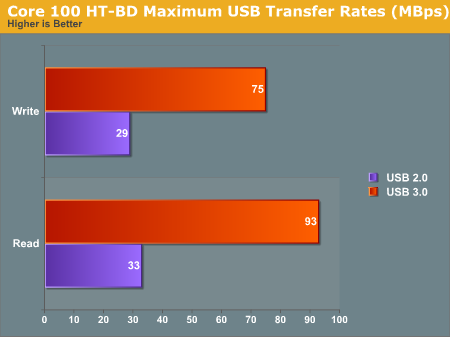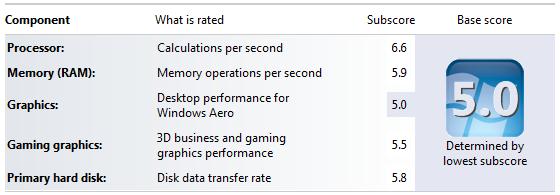ASRock Core 100HT-BD : Bringing HTPCs to the Mainstream Market [UPDATED : Noise Issue]
by Ganesh T S on July 19, 2010 9:34 PM EST- Posted in
- Home Theater
- Arrandale
- ASRock
- Media Streamer
- Core i3
- HTPC
Do the usual benchmarks really provide us with a proper indicator of the worthiness of a HTPC? Is that the performance seen by an average user in real life situations? Such questions often crossed my mind when I looked up the reviews of PCs on various websites. It is almost blasphemous if one were to suggest that the 'Windows Experience Index' is a reflection of what the average user sees. Such a synthetic benchmark might not be a true reflection of the capabilities of the system, but it at least gives an idea to the users as to how much better the system would be compared to the one they currently possess. HTPCs require a different set of performance measurement tests, and we will handle them in the next set of sections. In this, however, we will talk about the general performance metrics in brief.
For readers wanting a lowdown on the core performance aspect (in other words, graphs for various standardized benchmarks) of the motherboard used in this PC, I would suggest reviews from Legion Hardware and Benchmark Reviews. We found nothing in our experiments to dispute their findings. However, one important aspect we would like to cover here is the USB 3.0 performance.
USB 3.0 on the HM55 Chipset
We hooked up OCZ's Enyo 128 GB USB 3.0 external SSD (which has received glowing reviews everywhere with upto 200 MBps read and 190 MBps write speeds) to the front USB 3.0 ports of the Core 100 HT-BD. Contrary to our expectations, we managed to get a maximum of only 93 MBps read and 75 MBps write performance out of the drive. Connecting the same SSD to an USB 2.0 port resulted in a maximum of 33 MBps reads and 29 MBps writes, in line with expectations. We do not get the fabled 10x, but only a 2.7x, improvement over USB 2.0 with the Core 100 HT-BD's USB 3.0 implementation.

A little more analysis revealed that the HM55 chipset does not support PCI-E v2 fully and the bandwidth is limited by the chipset. To get around this limitation, ASRock could have placed a PLX bridge chip on board. We covered this workaround in detail in an earlier piece, but it doesn't make sense for ASRock to implement it in this product. The existing limitation will not be of concern to most users, as SSDs are yet to go mainstream (because of their cost). Most external hard disks with USB 3.0 or eSATA interfaces are inherently limited by the disk-to-buffer transfer rate of around 70 - 90 MBps, and ASRock's USB 3.0 implementation is capable of handling such bandwidth.
Windows Experience Index
A quick glance through the specifications of the system easily reveals the bottleneck affecting the score on the Windows Experience Index. It is none other than Intel's integrated GPU which ends up being the culprit. A screenshot of the Windows Experience Index shows the system chiming in at 5.0. However, we have seen the scores oscillate between 4.4 and 5.2 depending on the graphics driver version, as well as the GPU overclocking status.

Of particular interest is the impressive score received by the processor (6.6), indicating that the performance of this unit would be more than enough for most, if not all, HTPC applications.
DPC Latency Check
Another important criterion for HTPCs is the ability of the system to handle real time streaming of audio and video without dropouts. A handy tool called the DPC Latency Checker helps in analyzing this. This tool was run multiple times in various HTPC scenarios. We did observe red spikes, but disabling the C-states, as well as SpeedStep in the BIOS Advanced CPU configuration helped in alleviating the issue. However, we did not observe any dropouts or playback issues with Blu-Ray or any other media despite the sporadic occurrence of these spikes.
Miscellaneous Performance Indices
Pre-built HTPCs available today are mostly based on the ION chipset, and any comparative evaluation of the benchmark results of this system with ION systems would be grossly unfair for the ION. Both Benchmark Reviews and Legion Hardware compared the Core 100 HT with the ION 330, the 2009 HTPC model from ASRock. Comparing the performance of the Atom to the Core i3 is like comparing apples to oranges, but, for the record, the Core 100 HT system came out better on almost all counts except for the 3D and gaming performance.
On the memory bandwidth side, the Core 100 has more than 2x the performance of the ION 330. CPU performance is around 4 - 5x better. While games appeared to achieve almost similar frame rates on both the Core 100 and the ION 330, 3D performance in applications such as Maya went down by a factor of 2x in favour of the ION 330. Thankfully, applications such as video encoding (a common overnight task for most HTPCs) see a 3.5x performance improvement in the Core 100HT-BD.
In the next section, we will look at the integrated GPU of the Core i3-330M in detail.










107 Comments
View All Comments
tmservo - Tuesday, July 20, 2010 - link
This is a good point regarding tuners. I also wish there was an internal. But I can deal without. Right now, I have 4 tuners: a SiliconDust dual tuner QAM (connects over ethernet) a 2250 and a ATI650. But I almost never watch that many programs at once, and with the cable companies limiting, they are on my elimination list. This fall SiliconDust is supposed to have their 3 tuner CableCard solution out. At the moment they have that, my need of any cards in my PC completely go away. Completely goes away. I'll have better TV input.Now, I wish there was a single PCI-E x1 slot so I could consider the Ceton, but I could deal.
jnmfox - Tuesday, July 20, 2010 - link
Surprised Silicon Dust's HDHomeRun hasn't been mentioned:http://www.silicondust.com/products/hdhomerun/atsc...
One of the best tuners around and will work on any networked PC. Plus you don't have to add bulk to your HTPC by making it bigger to fit a tuner inside. One of the best HTPC purchases I've made.
Braumin - Wednesday, July 21, 2010 - link
Everyone needs a different tuner. Including any tuner would just be a waste of money since it would not be guaranteed to work on the owner's system. USB and Network tuners are available and make this a complete DVR.CharonPDX - Wednesday, July 21, 2010 - link
I already use an HD HomeRun as my tuner, so no internal tuner isn't a deal killer at all for me. (And I may get a second HD HomeRun.)jrwalte - Wednesday, July 21, 2010 - link
Did you ever consider using a USB tuner?EnzoFX - Wednesday, July 21, 2010 - link
There are probably more USB based tuners these days than internal tuners being made. Secondly, I strongly recommend the network based HDHomeRun tuner. Lastly, this is probably targeted at people who wouldn't want to install an internal tuner.RamIt - Tuesday, July 20, 2010 - link
Give me an expansion slot and I'll buy one. until then no thx.ganeshts - Tuesday, July 20, 2010 - link
RamIt,Most of what can be achieved through an expansion slot is possible using external USB devices. The Core 100 unit is quite liberal in that respect, providing 6 USB 2.0 ports and 2 USB 3.0 ports.
Also, note that the chipset used is the HM55. Compare this with a similarly spec-ed notebook computer. It is difficult for manufacturers to provide expansion slots, and even if they do, the costs of the devices fitting those slots are much higher than their external USB counterparts.
Stokestack - Tuesday, July 20, 2010 - link
Unfortunately, the only USB 3 ports are on the front. This is a mistake. People setting up a nice home-theater system don't want ugly wires hanging out of their components full-time.Receiver makers are making the same baffling mistake with USB ports for iPods. Why on earth would I want this wire dangling off the front of the unit all the time? A port on the back allows you to plug a dock, an external drive, or tuner in and keep it out of sight.
GeorgeH - Tuesday, July 20, 2010 - link
At $700 this will be competing with the Mac Mini. It has superior hardware specs, but if I were looking for something small, quiet, and attractive to put in my living room the Mini would win easily. This box is just to close to a basic mini-ITX box that any troglodyte could throw together - ASRock really needs to leverage their ability to make completely custom parts before they have a truly compelling product.It's cool to see more high-powered boxes in this form factor, I just wish it had been executed better.